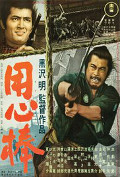
Directed by
Akira Kurowasa
110 minutes
Rated PG
Reviewed by
Bernard Hemingway

Yojimbo
Anyone familiar with akira Kurosawa's classic samurai films like Rashomon (1950) and The Seven Samurai (1954) may well be disconcerted by the director’s self-parodic and sometimes near-slapstick approach here. In part this is because he is hybridising the samurai genre, of which he is the most famous exponent, with the Hollywood Western and a sense of playfulness abounds. Of course it is well known that this stylistic cross-fertilization was taken even further by Sergio Leone when he remade Kurosawa's film as A Fistful of Dollars in 1964 (it was also remade in 1996 by Walter Hill as Last Man Standing, a Bruce Willis vehicle that I have not seen but which was, by all accounts, execrable).
One can certainly see in the central character Sanjuro (Toshiro Mifune in his ninth film for Kurosawa), a ronin or sword-for-hire, the seeds of Leone’s Man With No Name, much being made of his ‘outsider’ social standing, part pariah, part free spirit, although Sanjuro is more human and anyone looking for a comparable mythic hero will be disappointed. In this respect the film at times appears to be too off-hand and, one might suggest that it owes a large debt to Leone's borrowings for its continuing reputation. For those interested in the phallic implications of the gun in Westerns the scene between Sanjuro and his rival, the pistol-toting and incongruously effeminate Unosuké, is one of the most salient I can recall since that between Montgomery Clift and John Ireland in Howard Hawks’ Red River (1948).
Want something different?





